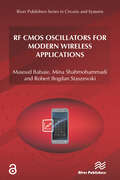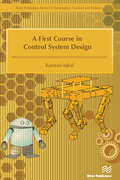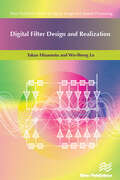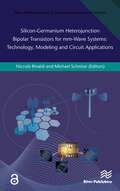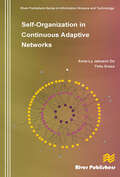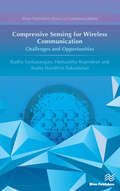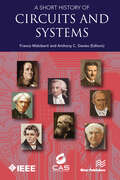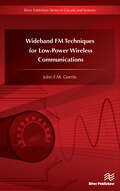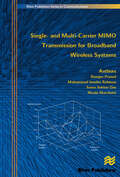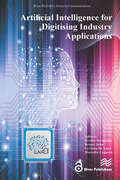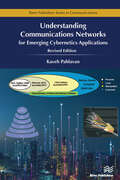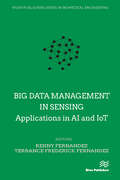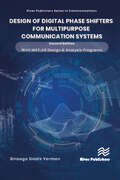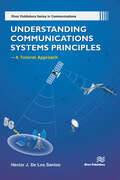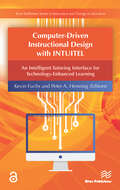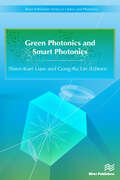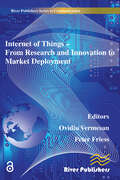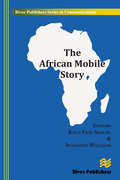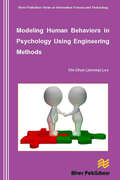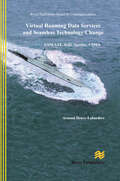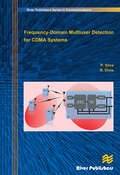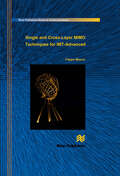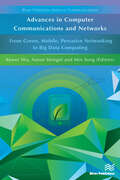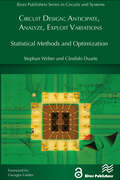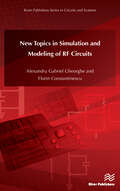- Table View
- List View
RF CMOS Oscillators for Modern Wireless Applications
by Masoud Babaie Mina Shahmohammadi Robert Bogdan StaszewskiWhile mobile phones enjoy the largest production volume ever of any consumer electronics products, the demands they place on radio-frequency (RF) transceivers are particularly aggressive, especially on integration with digital processors, low area, low power consumption, while being robust against process-voltage-temperature variations. Since mobile terminals inherently operate on batteries, their power budget is severely constrained. To keep up with the ever increasing data-rate, an ever-decreasing power per bit is required to maintain the battery lifetime. The RF oscillator is the second most power-hungry block of a wireless radio (after power amplifiers). Consequently, any power reduction in an RF oscillator will greatly benefit the overall power efficiency of the cellular transceiver. Moreover, the RF oscillators' purity limits the transceiver performance. The oscillator's phase noise results in power leakage into adjacent channels in a transmit mode and reciprocal mixing in a receive mode. On the other hand, the multi-standard and multi-band transceivers that are now trending demand wide tuning range oscillators. However, broadening the oscillator’s tuning range is usually at the expense of die area (cost) or phase noise.The main goal of this book is to bring forth the exciting and innovative RF oscillator structures that demonstrate better phase noise performance, lower cost, and higher power efficiency than currently achievable. Technical topics discussed in RF CMOS Oscillators for Modern Wireless Applications include: Design and analysis of low phase-noise class-F oscillators Analyze a technique to reduce 1/f noise up-conversion in the oscillators Design and analysis of low power/low voltage oscillators Wide tuning range oscillators Reliability study of RF oscillators in nanoscale CMOS
A First Course in Control System Design
by Kamran IqbalControl systems are pervasive in our lives. Our homes have environmental controls. The appliances we use at home, such as the washing machine, microwave, etc. have embedded controllers. We fly in airplanes and drive automobiles, which make extensive use of control systems. The increasing automation in the past few decades has increased our reliance on control systems.A First Course in Control System Design discusses control systems design from a model-based perspective as applicable to single-input single-output systems. The emphasis in this book is on understanding and applying the techniques that enable the design of effective control systems. The book covers the time-domain and the frequency-domain design methods, as well as the design of continuous-time and discrete-time systems.Technical topics discussed in the book include: Modeling of physical systems Analysis of transfer function and state variable models Control system design via root locus Control system design in the state-space Control design of sampled-data systems Compensator design via frequency response modification
Digital Filter Design and Realization
by Takao Hinamoto Wu-Sheng LuAnalysis, design, and realization of digital filters have experienced major developments since the 1970s, and have now become an integral part of the theory and practice in the field of contemporary digital signal processing. Digital Filter Design and Realization is written to present an up-to-date and comprehensive account of the analysis, design, and realization of digital filters. It is intended to be used as a text for graduate students as well as a reference book for practitioners in the field. Prerequisites for this book include basic knowledge of calculus, linear algebra, signal analysis, and linear system theory. Technical topics discussed in the book include:Discrete-Time Systems and z-TransformationStability and Coefficient SensitivityState-Space ModelsFIR Digital Filter DesignFrequency-Domain Digital Filter DesignTime-Domain Digital Filter DesignInterpolated and Frequency-Response-Masking FIR Digital Filter DesignComposite Digital Filter DesignFinite Word Length EffectsCoefficient Sensitivity Analysis and MinimizationError Spectrum ShapingRoundoff Noise Analysis and MinimizationGeneralized Transposed Direct-Form IIBlock-State Realization
Silicon-Germanium Heterojunction Bipolar Transistors for Mm-wave Systems Technology, Modeling and Circuit Applications
The semiconductor industry is a fundamental building block of the new economy, there is no area of modern life untouched by the progress of nanoelectronics. The electronic chip is becomingan ever-increasing portion of system solutions, starting initially from less than 5% in the 1970 microcomputer era, to more than 60% of the final cost of a mobile telephone, 50% of the price of a personal computer (representing nearly 100% of the functionalities) and 30% of the price of a monitor in the early 2000’s.Interest in utilizing the (sub-)mm-wave frequency spectrum for commercial and research applications has also been steadily increasing. Such applications, which constitute a diverse but sizeable future market, span a large variety of areas such as health, material science, mass transit, industrial automation, communications, and space exploration.Silicon-Germanium Heterojunction Bipolar Transistors for mm-Wave Systems Technology, Modeling and Circuit Applications provides an overview of results of the DOTSEVEN EU research project, and as such focusses on key material developments for mm-Wave Device Technology. It starts with the motivation at the beginning of the project and a summary of its major achievements. The subsequent chapters provide a detailed description of the obtained research results in the various areas of process development, device simulation, compact device modeling, experimental characterization, reliability, (sub-)mm-wave circuit design and systems.
Self-Organization in Continuous Adaptive Networks
by Anne-Ly Do Thilo GrossIn the last years, adaptive networks have been discovered simultaneously in different fields as a universal framework for the study of self-organization phenomena. Understanding the mechanisms behind these phenomena is hoped to bring forward not only empirical disciplines such as biology, sociology, ecology, and economy, but also engineering disciplines seeking to employ controlled emergence in future technologies. This volume presents new analytical approaches, which combine tools from dynamical systems theory and statistical physics with tools from graph theory to address the principles behind adaptive self-organization. It is the first class of approaches that is applicable to continuous networks. The volume discusses the mechanisms behind three emergent phenomena that are prominently discussed in the context of biological and social sciences:• synchronization,• spontaneous diversification, and• self-organized criticality.Self-organization in continuous adaptive networks contains extended research papers. It can serve as both, a review of recent results on adaptive self-organization as well as a tutorial of new analytical methodsSelf-organization in continuous adaptive networks is ideal for academic staff and master/research students in complexity and network sciences, in engineering, physics and maths.
Compressive Sensing for Wireless Communication: Challenges and Opportunities
by Radha Sankararajan Hemalatha Rajendran Aasha Nandhini SukumaranCompressed Sensing (CS) is a promising method that recovers the sparse and compressible signals from severely under-sampled measurements. CS can be applied to wireless communication to enhance its capabilities. As this technology is proliferating, it is possible to explore its need and benefits for emerging applicationsCompressive Sensing for Wireless Communication provides:• A clear insight into the basics of compressed sensing• A thorough exploration of applying CS to audio, image and computer vision• Different dimensions of applying CS in Cognitive radio networks• CS in wireless sensor network for spatial compression and projection• Real world problems/projects that can be implemented and tested• Efficient methods to sample and reconstruct the images in resource constrained WMSN environmentThis book provides the details of CS and its associated applications in a thorough manner. It lays a direction for students and new engineers and prepares them for developing new tasks within the field of CS. It is an indispensable companion for practicing engineers who wish to learn about the emerging areas of interest.
A Short History of Circuits and Systems
by Franco Maloberti Anthony C. DaviesAfter an overview of major scientific discoveries of the 18th and 19th centuries, which created electrical science as we know and understand it and led to its useful applications in energy conversion, transmission, manufacturing industry and communications, this Circuits and Systems History book fills a gap in published literature by providing a record of the many outstanding scientists, mathematicians and engineers who laid the foundations of Circuit Theory and Filter Design from the mid-20th Century. Additionally, the book records the history of the IEEE Circuits and Systems Society from its origins as the small Circuit Theory Group of the Institute of Radio Engineers (IRE), which merged with the American Institute of Electrical Engineers (AIEE) to form IEEE in 1963, to the large and broad-coverage worldwide IEEE Society which it is today.Many authors from many countries contributed to the creation of this book, working to a very tight time-schedule. The result is a substantial contribution to their enthusiasm and expertise which it is hoped that readers will find both interesting and useful. It is sure that in such a book omissions will be found and in the space and time available, much valuable material had to be left out. It is hoped that this book will stimulate an interest in the marvellous heritage and contributions that have come from the many outstanding people who worked in the Circuits and Systems area.
Wideband FM Techniques for Low-Power Wireless Communications
by John F.M. GerritsUltra Wideband (UWB) communications are poised to enable short-range applications, such as remote health monitoring (e-health) and home or office automation. Sensor networks are also suitable candidates for UWB since the low radiated power of the UWB transmitter enables low DC power consumption, yielding long battery life and the possibility to use energy scavenging. Size and cost constraints require a low-complexity approach that allows multiple users to share the same RF bandwidth, and offers robustness to interference, frequency-selective multipath and antenna mismatch. Wideband FM Techniques for Low-Power Wireless Communications presents research and applications that have taken place in UWB Communications over the past years. This book is being published posthumously in agreement with the authors’ former colleagues from both the Swiss Center for Electronics and Microtechnology (CSEM) and Delft University of Technology in The Netherlands.
Single- And Multi-Carrier Mimo Transmission for Broadband Wireless Systems
by Ramjee Prasad Muhammad Imadur Rahman Sekhar Suvra DasThe main focus of Single- and Multi-Carrier MIMO Transmission for Broadband Wireless Systems is to provide the basic understanding of the underlying techniques related to PHY-MAC design of future wireless systems. It includes basic concepts related to single- and multi-carrier transmissions together with MIMO techniques. Discussions related to different recent standards that use single- and multi-carrier transmissions are also explained.Single- and Multi-Carrier MIMO Transmission for Broadband Wireless Systems provides a comprehensive and holistic approach to the variety of technical solutions. Future system design would require these different technologies to work together, and not independently. Therefore, it is very important to analyze the effects and gains when they are put together in a unified platform. This is the prime focus of this book. Moreover, the authors include recent research results which are not yet published in another form. The book is intended to be used for lectures in graduate level courses at universities. PhD level students should also find it useful as this book will outline the fundamental concepts and design methods for PHY and MAC layers of future wireless systems. This book can also be used as a reference by engineers and developers in the industry as well as by researchers in academia. For professionals, system architects and managers who play a key role in the selection of a baseline system concept for future wireless standards, such as IMT-Advanced type architecture, the authors will include discussions, analysis and guidelines to highlight overall system level perspective.
Artificial Intelligence for Digitising Industry – Applications
This book provides in-depth insights into use cases implementing artificial intelligence (AI) applications at the edge. It covers new ideas, concepts, research, and innovation to enable the development and deployment of AI, the industrial internet of things (IIoT), edge computing, and digital twin technologies in industrial environments. The work is based on the research results and activities of the AI4DI project, including an overview of industrial use cases, research, technological innovation, validation, and deployment. This book’s sections build on the research, development, and innovative ideas elaborated for applications in five industries: automotive, semiconductor, industrial machinery, food and beverage, and transportation. The articles included under each of these five industrial sectors discuss AI-based methods, techniques, models, algorithms, and supporting technologies, such as IIoT, edge computing, digital twins, collaborative robots, silicon-born AI circuit concepts, neuromorphic architectures, and augmented intelligence, that are anticipating the development of Industry 5.0. Automotive applications cover use cases addressing AI-based solutions for inbound logistics and assembly process optimisation, autonomous reconfigurable battery systems, virtual AI training platforms for robot learning, autonomous mobile robotic agents, and predictive maintenance for machines on the level of a digital twin. AI-based technologies and applications in the semiconductor manufacturing industry address use cases related to AI-based failure modes and effects analysis assistants, neural networks for predicting critical 3D dimensions in MEMS inertial sensors, machine vision systems developed in the wafer inspection production line, semiconductor wafer fault classifications, automatic inspection of scanning electron microscope cross-section images for technology verification, anomaly detection on wire bond process trace data, and optical inspection. The use cases presented for machinery and industrial equipment industry applications cover topics related to wood machinery, with the perception of the surrounding environment and intelligent robot applications. AI, IIoT, and robotics solutions are highlighted for the food and beverage industry, presenting use cases addressing novel AI-based environmental monitoring; autonomous environment-aware, quality control systems for Champagne production; and production process optimisation and predictive maintenance for soybeans manufacturing. For the transportation sector, the use cases presented cover the mobility-as-a-service development of AI-based fleet management for supporting multimodal transport. This book highlights the significant technological challenges that AI application developments in industrial sectors are facing, presenting several research challenges and open issues that should guide future development for evolution towards an environment-friendly Industry 5.0. The challenges presented for AI-based applications in industrial environments include issues related to complexity, multidisciplinary and heterogeneity, convergence of AI with other technologies, energy consumption and efficiency, knowledge acquisition, reasoning with limited data, fusion of heterogeneous data, availability of reliable data sets, verification, validation, and testing for decision-making processes.
Understanding Communications Networks – for Emerging Cybernetics Applications
by Kaveh PahlavanInformation networking has emerged as a multidisciplinary diversified area of research over the past few decades. From traditional wired telephony to cellular voice telephony and from wired access to wireless access to the Internet, information networks have profoundly impacted our lifestyles as they have undergone enormous growth. To understand this technology, students need to learn several disciplines and develop an intuitive feeling of how they interact with one another. To achieve this goal, the book describes important networking standards, classifying their underlying technologies in a logical manner and gives detailed examples of successful applications.The emergence of wireless access and dominance of the Ethernet in LAN technologies has shifted the innovations in networking towards the physical layer and characteristics of the medium. This book pays attention to the physical layer while we provide fundamentals of information networking technologies which are used in wired and wireless networks designed for local and wide area operations. The book provides a comprehensive treatment of the wired IEEE802.3 Ethernet, and Internet as well as ITU cellular 2G-6G wireless networks, IEEE 802.11 for Wi-Fi, and IEEE 802.15 for Bluetooth, ZigBee and ultra-wideband (UWB) technologies. The novelty of the book is that it places emphasis on physical communications issues related to formation and transmission of packets and characteristics of the medium for transmission in variety of networks.Material presented in the book will be beneficial for students of Electrical and Computer Engineering, Computer Science, Robotics Engineering, Biomedical Engineering, or other disciplines who are interested in integration of navigation into their multi-disciplinary projects. The book provides examples with supporting MATLAB codes and hands-on projects throughout to improve the ability of the readers to understand and implement variety of algorithms.
Big data management in Sensing: Applications in AI and IoT
The book is centrally focused on human computer Interaction and how sensors within small and wide groups of Nano-robots employ Deep Learning for applications in industry. It covers a wide array of topics that are useful for researchers and students to gain knowledge about AI and sensors in nanobots. Furthermore, the book explores Deep Learning approaches to enhance the accuracy of AI systems applied in medical robotics for surgical techniques. Secondly, we plan to explore bio-nano-robotics, which is a field in nano-robotics, that deals with automatic intelligence handling, self-assembly and replication, information processing and programmability.
Design of Digital Phase Shifters for Multipurpose Communication Systems
by Binboga Siddik YarmanThis book aims to cover a new emerging need in designing digital phase shifter for modern communication systems. With the advancement of new generation mobile communication systems, directed beams of antenna arrays save a substantial amount of power as well as improve the communication quality. In this regard, beam-forming circuits, such as digital phase shifters (DPS) constitute essential parts of the antenna array systems. Therefore, this book is devoted to the design of digital phase shifters for various communications systems. Nowadays, phase array systems demand compact phase shifters suitable for chip implementation with wide phase-range and broad frequency band. Each chapter of this book is organized as stand-alone in such a way that the reader requires no specific background acquired from the other chapters. For each phase shifter topology introduced in this book, the reader is furnished with explicit design equations to construct the circuit under consideration. Furthermore, design equations are programmed using MATLAB to assess the electrical performance of the phase shifters with ideal and lossy components. MATLAB design programs are given at the and of each chapter as appendices and provided as soft copy on the web page of the book. In chapters 12 and 14, MMIC layouts for the lattice and T-section based DPS are provided for the readers. It is hoped that an interested reader can immediately identifies the “optimum phase shifter topology” for the need under consideration with its estimated electric performance.
Understanding Communications Systems Principles—A Tutorial Approach
by Héctor J. SantosWireless communications and sensing systems are nowadays ubiquitous; cell phones and automotive radars typifying two of the most familiar examples. This book introduces the field by addressing its fundamental principles, proceeding from its very beginnings, up to today's emerging technologies related to the fifth-generation wireless systems (5G), Multi-Input Multiple Output (MIMO) connectivity, and Aerospace/Electronic Warfare Radar. The tone is tutorial. Problems are included at the end of each chapter to facilitate the understanding and assimilation of the material to electrical engineering undergraduate/graduate students and beginning and non-specialist professionals. Free temporary access to Keysight's SystemVue system simulation is provided to further enhance reader learning through hands-on tutorial exercises.Chapter 1 introduces wireless communications and sensing and in particular how curiosity-driven scientific research led to the foundation of the field. Chapter 2 presents a brief introduction to the building blocks that make up wireless systems. Chapter 3 focuses on developing an understanding of the performance parameters that characterize a wireless system. Chapter 4 deals with circuit topologies for modulation and detection. In chapter 5 we cover the fundamental transmitter and receiver systems architectures that enable the transmission of information at precise frequencies and their reception from among a rather large multitude of other signals present in space. Chapter 6 introduces 5G, its motivation, and its development and adoption challenges for providing unprecedented levels of highest speed wireless connectivity. Chapter 7 takes on the topic of MIMO, its justification and its various architectures. Chapter 8 addresses the topic of aerospace/electronic warfare radar and finally Chapter 9 presents three Tutorials utilizing the SystemVue simulation tool.
Computer-Driven Instructional Design with INTUITEL
INTUITEL is a research project that was co-financed by the European Commission with the aim to advance state-of-the-art e-learning systems via addition of guidance and feedback for learners. Through a combination of pedagogical knowledge, measured learning progress and a broad range of environmental and background data, INTUITEL systems will provide guidance towards an optimal learning pathway. This allows INTUITEL-enabled learning management systems to offer learners automated, personalised learning support so far only provided by human tutors INTUITEL is - in the first place - a design pattern for the creation of adaptive e-learning systems. It focuses on the reusability of existing learning material and especially the annotation with semantic meta data. INTUITEL introduces a novel approach that describes learning material as well as didactic and pedagogical meta knowledge by the use of ontologies. Learning recommendations are inferred from these ontologies during runtime. This way INTUITEL solves a common problem in the field of adaptive systems: it is not restricted to a certain field. Any content from any domain can be annotated. The INTUITEL research team also developed a prototype system. Both the theoretical foundations and how to implement your own INTUITEL system are discussed in this book.
Green Photonics and Smart Photonics
In recent years, many efforts have been devoted in the study, development and application of Green Photonics and Smart Photonics. This book presents recent advances, both theoretical and applications, reflecting the cutting-edge technologies and research achievements within these research fields.Green Photonics intend to develop photonics technologies that can conserve energy, reduce pollution and create renewable energy. Light emitting diodes (LEDs) and solar cells with the characteristics of sustainable and low energy consumption are addressed in this book. The term of Smart Photonics reflect intelligence of optical and optoelectronic components with high sensitivity, fast response time and/or compact size. The book explores various aspects ofsmart photonics including fiber sensors, optoelectronic devices and waveguide devices. The chapters in this edited book are written by researchers who presented quality papers at the 2015 International Symposium of Next-Generation Electronics (ISNE 2015), which was held in Taipei, Taiwan. The ISNE 2015 provided a common forum in the areas of opto-electron devices, photonics, integrated circuits, and microelectronic systems and technologies. The technical program consisted of 5 plenary talks, 23 invited talks and more than 250 contributed oral and poster presentations. After a rigorous review process, the ISNE 2015 technical program committee has selected 10 outstanding presentations and invited the authors to prepare extended chapters for inclusion in this book. Of the 10 chapters, five focus on the subject of green photonics, and the others cover smart photonics.
Internet of Things Applications - From Research and Innovation to Market Deployment
The book aims to provide a broad overview of various topics of Internet of Things from the research, innovation and development priorities to enabling technologies, nanoelectronics, cyber physical systems, architecture, interoperability and industrial applications. It is intended to be a standalone book in a series that covers the Internet of Things activities of the IERC – Internet of Things European Research Cluster from technology to international cooperation and the global "state of play".The book builds on the ideas put forward by the European research Cluster on the Internet of Things Strategic Research Agenda and presents global views and state of the art results on the challenges facing the research, development and deployment of IoT at the global level. Internet of Things is creating a revolutionary new paradigm, with opportunities in every industry from Health Care, Pharmaceuticals, Food and Beverage, Agriculture, Computer, Electronics Telecommunications, Automotive, Aeronautics, Transportation Energy and Retail to apply the massive potential of the IoT to achieving real-world solutions. The beneficiaries will include as well semiconductor companies, device and product companies, infrastructure software companies, application software companies, consulting companies, telecommunication and cloud service providers. IoT will create new revenues annually for these stakeholders, and potentially create substantial market share shakeups due to increased technology competition. The IoT will fuel technology innovation by creating the means for machines to communicate many different types of information with one another while contributing in the increased value of information created by the number of interconnections among things and the transformation of the processed information into knowledge shared into the Internet of Everything. The success of IoT depends strongly on enabling technology development, market acceptance and standardization, which provides interoperability, compatibility, reliability, and effective operations on a global scale. The connected devices are part of ecosystems connecting people, processes, data, and things which are communicating in the cloud using the increased storage and computing power and pushing for standardization of communication and metadata. In this context security, privacy, safety, trust have to be address by the product manufacturers through the life cycle of their products from design to the support processes. The IoT developments address the whole IoT spectrum - from devices at the edge to cloud and datacentres on the backend and everything in between, through ecosystems are created by industry, research and application stakeholders that enable real-world use cases to accelerate the Internet of Things and establish open interoperability standards and common architectures for IoT solutions. Enabling technologies such as nanoelectronics, sensors/actuators, cyber-physical systems, intelligent device management, smart gateways, telematics, smart network infrastructure, cloud computing and software technologies will create new products, new services, new interfaces by creating smart environments and smart spaces with applications ranging from Smart Cities, smart transport, buildings, energy, grid, to smart health and life. Technical topics discussed in the book include: • Introduction• Internet of Things Strategic Research and Innovation Agenda• Internet of Things in the industrial context: Time for deployment.• Integration of heterogeneous smart objects, applications and services• Evolution from device to semantic and business interoperability• Software define and virtualization of network resources• Innovation through interoperability and standardisation when everything is connected anytime at anyplace• Dynamic context-aware scalable and trust-based IoT Security, Privacy framework• Federated Cloud service management and the Internet of Things• Internet of Things Applications
The African Mobile Story
Africa and especially Sub-Saharan Africa has during the past decade witnessed one of the fastest growing markets in mobile communication. This growth is recognized to have played a pivotal role in Africa’s socio-economic development. It has had a huge impact on residential living patterns; on business networks and models; and on government services and income sources. The mobile industry has contributed more to economic growth than in any other comparable region globally introducing innovative, broadly used applications. Technical topics discussed in the book include:• Mobile Development in Sub-Saharan Africa;• Telecom Liberalization in Africa;• Role of Mobile in Socio-economic Development;• Mobile Applications in specific sectors;• Security in African Mobile;• Role of Prepaid in Africa
Modeling Human Behaviors in Psychology Using Engineering Methods
by Chi-Chun LeeThe main purpose of the work is to showcase the interdisciplinary engineering approaches in modeling and understanding human behaviors during interpersonal interactions those that could be typical, distressed, or atypical. The ability to measure human behaviors quantitatively has been a core component and a major research direction in both fields of engineering and psychology – though often with distinct approaches designed for different targeted applications. Engineering methods often strive to achieve high predictive accuracies using behavioral informatics techniques; these techniques employ a combination of behavior measures derived using automated signal based descriptors, and of statistical frameworks modeled using machine learning techniques. These approaches are often distinct from the observational approaches the gold standard for the past three decades in the study of psychology, even in clinical settings. The observational approaches are largely based on human subjective judgments.
Virtual Roaming Data Services and Seamless Technology Change: GSM, LTE, WiFi, Satellite, CDMA
by Arnaud Henry-LabordèreThe subject is “Virtual Roaming for data services” and “Seamless Technology change” also called “Number Continuity”.“Virtual Roaming for voice and SMS” was covered in one of the author's previous book. “Virtual Roaming” means that it allows a subscriber to visit a network which his home network does not have an agreement with. The “Seamless Technology change” allows a user to keep all his services including reception of calls and SMS sent to his usual number when he switches his GSM to a Satellite phone or to WiFi. The implementation of Seamless Technology change uses the SS7 Roaming Hub and GTP Hubs technology explained in the first part of the book. The book also contains chapters explaining in detail the steering and anti-steering of roaming, LTE Serving Mobile Location Centers, and Advanced Policy and Charging implementations in LTE and 3G. This is to be used as an easy reference book. All the relevant references to the standards are included chapter by chapter. This is the first book on the two main subjects of Virtual Data Roaming and Seamless Technology change. Keywords:Virtual Roaming, Number Continuity, Seamless technology change, Policy Charging and Control, LTE LBS, Steering of Roaming, GTP Hub, MMS Hub,RADIUS Hub, DIAMETER Hub
Frequency-Domain Multiuser Detection for CDMA Systems
by Paulo Silva Rui DinisFuture broadband wireless communication systems are expected to be able to offer new and powerful services enabling fast transmission rates of several tens of Mbit/s. This is an ambitious challenge especially for mobile communication systems since these systems should be able to cope with severely time dispersive channels, associated to the signal multipath propagation. Moreover, these systems should have high spectral and power efficiencies, as well as high capacity and flexibility. Spread spectrum techniques, particularly coded division multiple access (CDMA) techniques allow high capacity and flexibility, continuous transmission requiring low-peak power requirements for the amplifiers, as well as some robustness against fading and time-dispersion effects associated with the multipath propagation. When employed in prefix assisted (PA) block transmission schemes combined with frequency-domain receiver implementations they become especially interesting for broadband wireless systems. In Frequency-Domain Multiuser Detection for CDMA Systems the use of PA block transmission is considered in the context of both DS (Direct Sequence) and MC (Multicarrier) CDMA schemes. The main goal is the study of frequency-domain multiuser detection techniques with iterative signal detection/decoding techniques, also in combination with estimation and cancelation of nonlinear distortion effects. The receiver structures are suitable to scenarios with high interference levels and strongly time-dispersive channels.
Single and Cross-Layer Mimo Techniques for Imt-Advanced
by Filippo MeucciIn the last two decades, the wireless arena has witnessed the emergence of an astonishing number of technologies which play a part in the definition of new wireless systems. Driven by the pressing capacity demand, the research community has developed several technological enablers. Fundamental technological building blocks that will be part of wireless systems in the near-future definitely include: Orthogonal Frequency Division Multiplexing (OFDM) modulation at the physical (PHY) layer, Multiple Input Multiple.Output (MIMO) systems, and a cross-layer (CL) stack design. While the benefits of OFDM have been recognized for several years, the real capacity improvement of MIMO antennae is still being debated today. As to the lastpoint, even if opportunities for CL have been pointed out for a long time, the impact on the actual legacy systems has not been noticeable, as investors are hesitant to implement the inherent design paradigm shift.Single and Cross-Layer MIMO Techniques for IMT-Advanced will present some advanced MIMO techniques where adaptivity, cross-layer approach, and MIMO antennae are analyzed together to show a deep impact on the sum-capacityachievable over the wireless link.The introduction presents the functional requirements for IMT-A candidate systems and the relation between IEEE802.16 and LTE wireless access networks. Then, in the first part, adaptive strategies are analyzedseparately at the PHY and Medium Access Control (MAC) layers. The second part presents an evolution of the previous approach, providing a cross-layer MIMO-ARQ protocol, where adaptive MIMO schemes, namely SpatialMultiplexing (SM) and STBC Alamouti, are used with ARQ protocol. A Multiple User (MU) network is served in DownLink (DL) with a Round Robin (RR) scheduler; the design is ready to include more advanced schedulers. The ARQstate machine at the MAC layer is aware of per-antenna ARQ. The interaction between the ARQ and the PHY layer, with a per-antenna ACK, allows resource exploitation to increase with per-antenna ACKs, shifting from MIMO Signal Processing Gain to MIMO Protocol Gain with no need for Channel State Information (CSI) feedback. The absence of CSI feedback at the PHY layer is an important characteristic of the proposedMIMO-ARQ cross-layer designs since MIMO CSI feedback (when feasible) drastically reduces the network efficiency.The added degrees of freedom offered by MIMO transmissions can make the difference if correctly exploited both at the physical and medium access layers, in particular for overcoming the problem of low MIMO channel ranks.The advantages of the paradigm shift from signal processing gain to protocol gain - together with the modifications to be applied at the classical protocol stack - are discussed in the final chapter.
Advances in Computer Communications and Networks From Green, Mobile, Pervasive Networking to Big Data Computing
Recent developments in computer communications and networks have enabled the deployment of exciting new areas such as Internet of Things and collaborative big data analysis. The design and implementation of energy efficient future generation communication and networking technologies also require the clever research and development of mobile, pervasive, and large-scale computing technologies. Advances in Computer Communications and Networks: from Green, Mobile, Pervasive Networking to Big Data Computing studies and presents recent advances in communication and networking technologies reflecting the state-of-the-art research achievements in novel communication technology and network optimization. Technical topics discussed in the book include: Data Center NetworksMobile Ad Hoc NetworksMultimedia NetworksInternet of ThingsWireless SpectrumNetwork Optimization.This book is ideal for personnel in computer communication and networking industries as well as academic staff and collegial, master, Ph.D. students in computer science, computer engineering, electrical engineering and telecommunication systems.
Circuit Design: Anticipate, Analyze, Exploit Variations
by Stephan Weber Candido DuarteCircuit Design = Science + Art! Designers need a skilled "gut feeling" about circuits and related analytical techniques, plus creativity, to solve all problems and to adhere to the specifications, the written and the unwritten ones. You must anticipate a large number of influences, like temperature effects, supply voltages changes, offset voltages, layout parasitics, and numerous kinds of technology variations to end up with a circuit that works. This is challenging for analog, custom-digital, mixed-signal or RF circuits, and often researching new design methods in relevant journals, conference proceedings and design tools unfortunately gives the impression that just a "wild bunch" of "advanced techniques" exist. On the other hand, state-of-the-art tools nowadays indeed offer a good cockpit to steer the design flow, which include clever statistical methods and optimization techniques.Actually, this almost presents a second breakthrough, like the introduction of circuit simulators 40 years ago! Users can now conveniently analyse all the problems (discover, quantify, verify), and even exploit them, for example for optimization purposes. Most designers are caught up on everyday problems, so we fit that "wild bunch" into a systematic approach for variation-aware design, a designer's field guide and more. That is where this book can help! Circuit Design: Anticipate, Analyze, Exploit Variations starts with best-practise manual methods and links them tightly to up-to-date automation algorithms. We provide many tractable examples and explain key techniques you have to know. We then enable you to select and setup suitable methods for each design task - knowing their prerequisites, advantages and, as too often overlooked, their limitations as well. The good thing with computers is that you yourself can often verify amazing things with little effort, and you can use software not only to your direct advantage in solving a specific problem, but also for becoming a better skilled, more experienced engineer. Unfortunately, EDA design environments are not good at all to learn about advanced numerics. So with this book we also provide two apps for learning about statistic and optimization directly with circuit-related examples, and in real-time so without the long simulation times. This helps to develop a healthy statistical gut feeling for circuit design. The book is written for engineers, students in engineering and CAD / methodology experts. Readers should have some background in standard design techniques like entering a design in a schematic capture and simulating it, and also know about major technology aspects.
New Topics in Simulation and Modeling of RF Circuits
by Alexandru Gabriel Gheorghe Florin ConstantinescuNew Topics in Simulation and Modeling of RF Circuits addresses two main topics: simulation of RF circuits and new models of nonlinear power BAW resonators and filters.Since RF circuits have several unique features, and all analysis methods are based on the circuit essential properties, the book begins by describing the properties of RF circuits, characterization of circuits with customary and uncustomary behavior and some theorems of solutions existence and uniqueness for dynamic nonlinear circuits. Thereafter, the main time domain and frequency domain analysis methods for RF circuits are presented. The advantages and disadvantages of each method have been highlighted, and an algorithm for the time step choice in transient analysis based on energy balance errors is also presented. Lastly, the final part contains some nonlinear circuit models of power BAW resonators. The behavioral models for the time domain analysis are simple circuits containing weakly nonlinear elements. The behavioral models for frequency domain analysis are based on the measured values of the frequency dependent S parameters for a set of incident powers. S parameters corresponding to certain intermodulation products of practical interest are also considered. The physical models contain artificial transmission lines with nonlinear circuit elements corresponding to mechanical and electrical nonlinearities.
